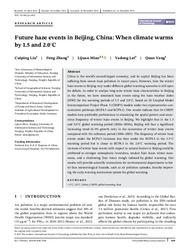Future haze events in Beijing, China: When climate warms by 1.5 and 2.0°C
DOI: https://doi.org/10.1002/joc.6421
Persistent URL: http://resolver.sub.uni-goettingen.de/purl?gldocs-11858/9408
Persistent URL: http://resolver.sub.uni-goettingen.de/purl?gldocs-11858/9408
Liu, Cuiping; Zhang, Feng; Miao, Lijuan; Lei, Yadong; Yang, Quan, 2019: Future haze events in Beijing, China: When climate warms by 1.5 and 2.0°C. In: International Journal of Climatology, Band 40, 8: 3689 - 3700, DOI: 10.1002/joc.6421.
 |
Dokument öffnen: |
China is the world's second-largest economy, and its capital Beijing has been suffering from severe haze pollution in recent years. However, how the winter haze events in Beijing vary under different global warming scenarios is still open for debate. In order to analyse long-term winter haze characteristics in Beijing in the future, we have simulated haze events using the haze weather index (HWI) for the warming periods of 1.5 and 2.0°C, based on 20 Coupled Model Intercomparison Project Phase 5 (CMIP5) models under two representative concentration pathways (RCP4.5 and RCP8.5). Our results indicate that 16 CMIP5 models have preferable performance in simulating the spatial pattern and occurrence frequency of winter haze events in Beijing. We highlight that in the 1.5 and 2.0°C global warming period (2020s–2050s), Beijing will face a significant increasing trend (6–9% growth rate) in the occurrence of winter haze events compared with the reference period (1986–2005). The frequency of winter haze events under the RCP4.5 increases less than under the RCP8.5 in the 1.5°C warming period but is closer to RCP8.5 in the 2.0°C warming period. The increase of winter haze events with respect to natural factors in Beijing could be attributed to stronger atmospheric inversions, weaker East Asian winter monsoons, and a shallowing East Asian trough induced by global warming. Our results will provide scientific instructions for environmental departments to better face meteorological hazards, such as air pollution episodes, thereby improving the early warning mechanism system for global warming.
Statistik:
ZugriffsstatistikSammlung:
This is an open access article under the terms of the Creative Commons Attribution License, which permits use, distribution and reproduction in any medium, provided the original work is properly cited.

